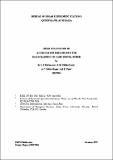| Abstract | Sugarcane weevil borer, Rhobdoscelus obscurus (Boisduval) (Coleoptera: Curculionidae: Rhynchophorinae), is native to Papua New Guinea, but was accidentally introduced to Queensland, Hawaii and Fiji with imported sugarcane material in the late 1800x (Veitch 1917). the larval stage is a serious pest of commercial sugarcane in those countries, and is also a minor pest of palms in queensland (Halfpapp and Storey 1991). Males of several species of Rhynchophorinae are known to produce pheromones which attract both males and females (Giblin-Davis et al. 1996.) Chang and Curtis (1972) first showed that males of R. obscurus release a pheromone after feeding on fermenting sugarcane. Fermenting sugarcane is also attractive to R. obscurus (Bell 1937). The aggregation pheromones of several species of Rhynchophorinae have been chemically identified and synthesised. Oehlschlager et al. (1995) has tested synthetic rhynchophorol as a method of removal trapping of the palm weevil, Rhynchophorus palmarum (L.), in oil palm plantations in Costa Rica. |

